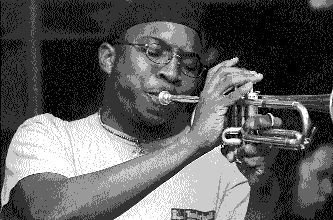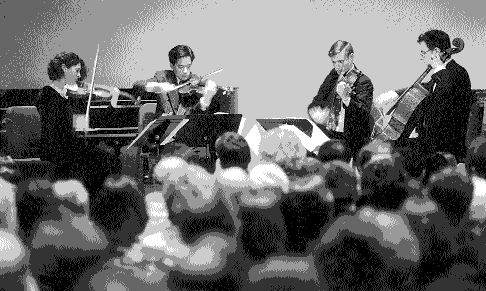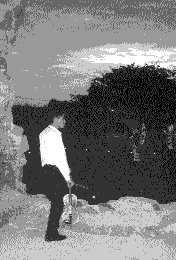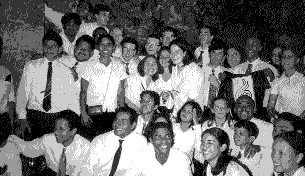OBERLIN CONSERVATORY WINTER TERM PROJECTS TAKE
STUDENTS TO WASHINGTON, D.C. AND PANAMA Performing on $50 million dollar Stradivarius instruments in the Smithsonian Institution's Hall of Musical Instruments. Learning that the second movement from Shostakovich's 8th string quartet reminded third graders of scenes from Alfred Hitchcock's Psycho. Musical coachings under banana trees. Riding to rehearsals in the "pollomobile." Performing in the ruins of Old Panama City. These are just a few of the highlights from two winter term projects. Music had no geographical boundaries in January 1999, when one group of Conservatory students performed on $50 million dollar Stradivarius instruments at the Smithsonian Institution, while another group of Connies rehearsed under banana trees in Panama. These are two highlights of recent winter term projects that had students packing their instruments and sheet music, and taking it on the road. 
One group, the Marina Quartet, flew to Washington, D.C., staged two concerts at the Smithsonian Institution (one of these on magnificent Stradivarius instruments), and performed nine concerts at six Washington, D.C. schools. Another group of 11 students, accompanied by Timothy Weiss, associate professor of wind conducting, headed to Panama for the ninth annual Panama Project. The group worked with a 55-member youth orchestra, offered chamber music and orchestral coachings, private lessons, master classes and performances. Regardless of location, each project was a 24-hour immersion in music, beginning with early morning classes and perform-ances, and ending with late-night musical activities. In the process, Conservatory musicians gained valuable performance experience in important and unusual venues and honed pedagogical skills. |
||||||||
|
WINTER TERM SUMMARIES
WASHINGTON, DC
|
||||||||
|
The Intensive String Quartet Seminar, offered during Oberlin's winter term for the past 15 years, focuses on performance and educational outreach. For this second annual trip to D.C., students created a new quartet - The Marina Quartet - comprised of Mirabai Weismehl, Artist Diploma '00, senior Elbert Tsai on violins, senior Michael Fenton on viola and sophomore Adam Friedberg on cello. The quartet first flew to San Francisco, Calif., where they rehearsed four hours a day and received two faculty coachings per week. During a full week in D.C., they performed two concerts in the Hall of Musical Instruments at the Smithsonian's National Museum of American History, the result of a relationship between the Smithsonian Chamber Music Society (whose director, Kenneth Slowik, is artistic director of the Oberlin Baroque Performance Institute) and Oberlin Conservatory. For an evening concert, the students performed on historic Stradivarius instruments, generously donated to the Smithsonian by Herbert and Evelyn Axelrod. Following the evening concert, the Oberlin College Alumni Association hosted a reception at the Smithsonian for approximately 250 alumni and guests. The group also performed nine concerts at six Washington, D.C. schools, including the Duke Ellington High School, St. Albans, the National Cathedral School, the Maret School, the Washington International School, and the Levine School of Music (at both the Northwest and Southeast campuses), where they worked with members of the Public Housing Orchestra. |
Michael Fenton, of Oakland, Calif., described the experience of performing on a Stradivarius: "The joy of playing on the 1695 viola was having all the things I struggle with on my instrument come so easily. Sound quality and even articulation virtually took care of themselves, and I was left with this incredible freedom to explore new sounds, to pay undivided attention to the music. Having that experience now leaves me with the task of trying to stretch my musical boundaries on my own instrument. "The day of the big concert was doubly memorable because I not only had the opportunity to play on the Stradivarius viola, but I also was able to meet the maker of my own viola, Robert McCluskie, who lives near Bethesda, MD. It was fascinating to talk with him and really get a feeling for the continuity between the 1695 Stradivarius viola I played that evening and my own 1992 McCluskie viola. After 300 years, the tradition of instrument making is still alive and well!" Mirabai Weismehl of San Anselmo, Calif., said, "This experience offered many rewards. Musically, I found myself listening better to myself and the quartet as I became more familiar with the repertoire and the dynamic of the quartet. The school children and their teachers were appreciative of our efforts, and invited Oberlin to continue the annual tradition of sending a quartet to play for and talk with the kids. We met kind people including Dean and Josephine Hoge '61, our hosts; Paul Yarbrough, violist of the Alexander Quartet (our San Francisco coach), and Kenneth Slowik, founder of the Smithsonian Chamber Music Society, who gave us coachings in D.C. |
"And we were honored with the opportunity to play on these Stradivarius instruments, known to be among the finest in existence today. This was a dream come true. The Axelrod quartet of Stradivarius instruments, housed at the Smithsonian's National Museum of American History (NMAH), was glorious. On these instruments we took advantage of our opportunity to produce brilliance of sound and variety of tone color. I could only wish the same for other musicians." Elbert Tsai of Albany, Calif., discussed the teaching component of the D.C. project. "The outreach programs were the highlight of my week. It's a wonderful experience to bring music to people for the first time, and many of these students had never before heard a live classical music concert. The students ranged from third graders to high school seniors, so a big challenge was to reach all members of the audiences. We performed contrasting characters in Schubert's Quartetsatz, and compared different minuets of Beethoven and Shostakovich. We played Bach chorales for the younger ones and left out an inner voice to see if they could identify what was missing." Tsai added, "The second movement from Dmitri Shostakovich's 8th string quartet drew the most attention. When asked what they thought about as it was performed, they offered chase scenes from films, and images from Alfred Hitchcock's Psycho. One kid, in learning that the piece was dedicated to the victims of World War II, asked why the music wasn't more passive or solemn. That's a pretty astute question from a fourth or fifth grader. It's fascinating to watch the creative mind of a young child digest a piece of music he or she is hearing for the first time." |
||||||
|
THE PANAMA PROJECT
1999 marks the ninth consecutive year of the Panama Project, an annual winter term cultural exchange between Conservatory students and more than 130 Panamanian musicians, aged six &endash; 26. For two weeks, 11 Conservatory students, accompanied by Timothy Weiss, associate professor of wind conducting, worked with two youth orchestras, offered chamber music coachings, private lessons, master classes and performances. The group spent one week at a music camp in Panama City&emdash;IXV Campamento Musical Juventil&emdash;held at the Catholic University. Mornings were devoted to a music preparatory program with children under 12 years of age; afternoons were dedicated to older students in chamber and orchestral work. For the second week, students traveled two hours by bus from Panama City to a convent in the more remote mountain region of El Valle. Conservatory students offered nine performances together, and in combination with Panamanian chamber ensembles and orchestra. Concert venues ranged from Panama City to rural mountain communities, including schools, a university, churches and Ruinas de Panama Viejo, the beautiful stone ruins of Old Panama City. The 11 Conservatory students of the Panama Project were: Henry Buchtel '01, Rodica Filipoi '99, Benjamin Fox '01, Elizabeth Freivogel '99, Katayoon Hodjati '99, Briana Knull '99, Kyle Lane '01, Joshua Rubin '99, Daniel Stachyra '99, Jennifer Wyatt '99 and Pieter Wyckoff '00. This visit was the second trip to Panama for violinist Filipoi, of Ridgefield, Wash. "Perhaps you had to experience it firsthand to understand how much these young musicians look forward to our return," she said. "There's an amazing feeling of appreciation. For example, many families in Panama City donated time, food, transportation and lodging for our visit. In El Valle, the man who drives the chicken truck - "the Pollomobile" - donated his time, his driving and his truck to get us to rehearsals. We all crammed into the back of the chicken truck with our instruments tucked under our feet and sang as we went to rehearsals. "It's almost overwhelming to listen as a village church bell rings to signal the beginning of a concert and then watch as people immediately come outdoors and head down the streets to attend. Many of these people had never seen instruments like ours. Many had never heard classical music performed live. There's a wonderful feeling of satisfaction in contributing to a larger musical world. I feel like I've done something important in sharing something that I love: music. As a bonus, I've made lasting friendships." The Conservatory works closely with the National Concert Association in Panama, a nonprofit organization that each year provides vital project coordination (scheduling, room and board, performance venues, ground transportation and partial funding). |
||||||||
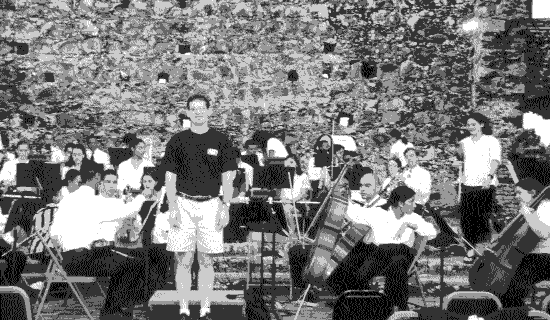
|
||||||||
